Creatures big and small
Scientists think of Tejon Ranch as an ecological hotspot: a highly unusual concentration of many different plants and animals. Why such biological diversity? Tejon Ranch cuts a generous swath of natural habitat where California’s Great Central Valley, Mojave Desert, Sierra Nevada, and South Coast meet. Here, these four otherwise distinct eco-regions make up a seamless patchwork of abundance.
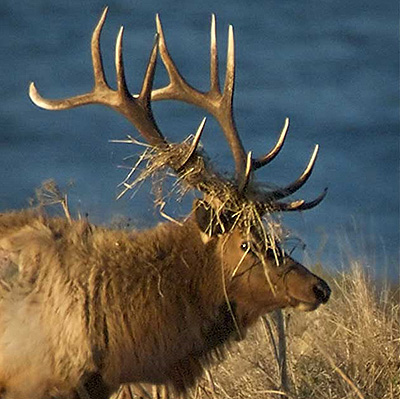
Tule elk with grass in his rack.
Photo: Peter Neibert © 2006
The Tule elk herds on Tejon are a remnant population of the vast herds that once roamed the San Joaquin Valley. |
Tejon Ranch is home to as many as 80 imperiled species, including the San Joaquin Kit Fox, California Spotted Owl, the Tehachapi Slender Salamander, and many other plants and animals that live nowhere else on Earth. California Condors soar overhead, and much of Tejon is already designated as critical habitat for this special bird—a creature whose comeback rightly trumpets the success of the Endangered Species Act.
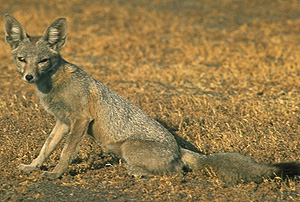 San Joaquin Kit Fox. San Joaquin Kit Fox.
Photo: Dr. Lloyd Glenn Ingles © 1999, California Academy of Sciences |
The San Joaquin Kit Fox averages 51 centimeters (20 inches) long and stands about 30 centimeters (12 inches) high at the shoulder. The summer coat is light buff to gray on the back, white on the belly; the winter coat is grizzled gray on the back, rust to buff on the sides, and white beneath. The tail is distinguished by a prominent black tip. The San Joaquin Kit Fox is found only in the west side of the San Joaquin Valley in Merced County, and in Kern and San Luis Obispo counties. (Status: Federal—endangered; State—threatened.) |
|
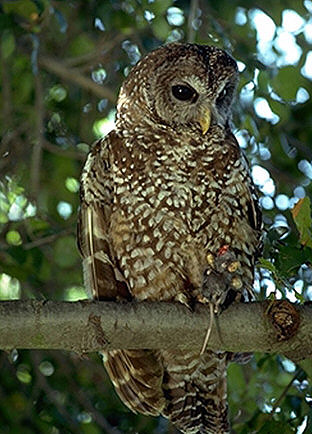 California Spotted Owl.
California Spotted Owl.
Photo: Gerald and Buff Corsi © 1999,
California Academy of Sciences |
The California Spotted Owl is a nocturnal, woodland owl. Their darkly colored plumage is heavily spotted with white on the breast and belly, with fewer spots on the wings, back, and head. They have round heads and dark brown eyes. (Status: Federal—threatened; State—species of concern.)
|
|
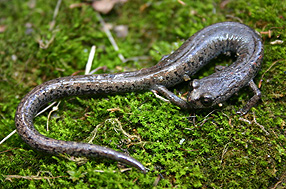 Tehachapi Slender Salamander. Tehachapi Slender Salamander.
Photo: William Flaxington © 2006 |
The secretive Tehachapi Slender Salamander is one of the rare species on the Tejon Ranch. It is found on north-facing slopes under decomposing logs or rocky talus. Little is known about this cryptic species.
|
Tejon Ranch provides a crucial biological connection between adjacent protected natural lands for a cornucopia of plants and creatures. A new Tejon Natural Park would significantly reduce planned development and protect wide open lands where elk and antelope could comfortably roam; mountain lions, coyotes, deer, pollinating insects, and even plant seeds would also move freely and safely here.
 Coreopsis.
Coreopsis.
Photo: I. Anderson © 2003, Center for Biological Diversity |
Native coreopsis (Coreopsis bigelovii) are one of many different types of wildflowers that form carpets on Tejon Ranch.
|
|
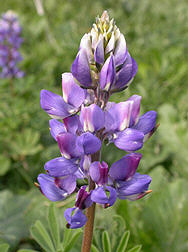
Lupine.
Photo: I. Anderson © 2003
Center for Biological Diversity
|
Purple lupines (Lupinus sp.) not only form beautiful fields, but also help re-energize the soil, by “fixing” nitrogen (a significant component of fertilizer) from the atmosphere into a usable form for plants in soil. |
|

Popcorn flower.
Photo: I. Anderson © 2006, Center for Biological Diversity
|
Popcorn flowers (Cryptantha sp.) have tiny white flowers along unfurling stems. Hardly showy themselves, their blooms always add a dramatic component when interspersed with other wildflowers. |
In the springtime months of March through June, Tejon plays host to nature’s glory. A pleasing jumble of wildflowers carpets the slopes of Tejon Ranch—from purple lupines, golden coreopsis, and goldfields to brilliant orange poppies and demure popcorn flowers.

Pronghorn Antelope.
Photo: Robin Silver © 2006, Center for Biological Diversity
|
Pronghorn Antelope are the namesake for the Antelope Valley, and herds still roam the arid grasslands on Tejon Ranch.
|
|
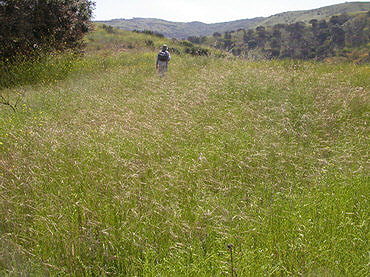 California Native Bunchgrass Grassland.
California Native Bunchgrass Grassland.
Photo: I. Anderson © 2005, Center for Biological Diversity |
California native grasslands are a rare plant community. Native grasses are typically perennial bunchgrasses like these purple needlegrasses (Nassella pulchra), which flower in the spring and stay green all year. Native grasslands are rare because they have been hard hit by development, agriculture, and overgrazing by livestock.
|
|
 California Juniper.
California Juniper.
Photo: I. Anderson © 2006, Center for Biological Diversity |
The shrubby California juniper rarely exceeds 25 feet. This tree is covered with frosty blue berries.
|
Oaks thrive here: in fact, a new Tejon Natural Park would host the most diverse oak community in California (towering valley oaks and their diminutive cousins, the scrub oaks, are just two of many that shade both rambler and denizen here). Lush native grasslands on Tejon’s east side are a natural treasure since that plant community has been all but eliminated throughout most of the West. Healthy grasslands here support Pronghorn Antelope, the namesake for the adjacent Antelope Valley, which historically supported vast herds.
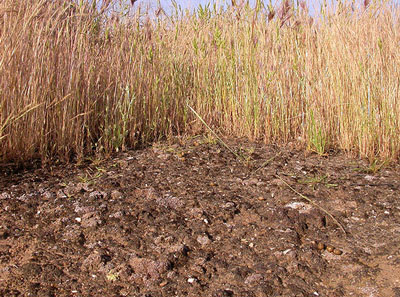
Microbiotic soil crust in foreground with exotic annual grasses behind.
Photo: I. Anderson © 2005, Center for Biological Diversity
Microbiotic soils are made up of numerous tiny organisms, usually a combination of algae, fungi and lichens. They provide multiple natural services including soil stabilization, water retention, and a hospitable substrate for seed germination—all of which in turn reduce air pollution from dust and downstream flooding of communities. Microbiotic soils also limit the spread of invasive exotic plant species (like the non-native grasses shown in the background). |
|
